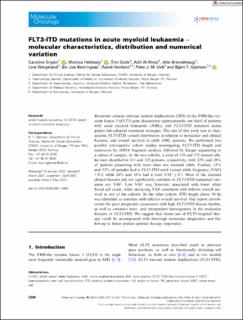| dc.description.abstract | Recurrent somatic internal tandem duplications (ITD) in the FMS-like tyrosine kinase 3 (FLT3) gene characterise approximately one third of patients with acute myeloid leukaemia (AML), and FLT3-ITD mutation status guides risk-adapted treatment strategies. The aim of this work was to characterise FLT3-ITD variant distribution in relation to molecular and clinical features, and overall survival in adult AML patients. We performed two parallel retrospective cohort studies investigating FLT3-ITD length and expression by cDNA fragment analysis, followed by Sanger sequencing in a subset of samples. In the two cohorts, a total of 139 and 172 mutant alleles were identified in 111 and 123 patients, respectively, with 22% and 28% of patients presenting with more than one mutated allele. Further, 15% and 32% of samples had a FLT3-ITD total variant allele frequency (VAF) < 0.3, while 24% and 16% had a total VAF ≥ 0.7. Most of the assessed clinical features did not significantly correlate to FLT3-ITD numerical variation nor VAF. Low VAF was, however, associated with lower white blood cell count, while increasing VAF correlated with inferior overall survival in one of the cohorts. In the other cohort, ITD length above 50 bp was identified to correlate with inferior overall survival. Our report corroborates the poor prognostic association with high FLT3-ITD disease burden, as well as extensive inter- and intrapatient heterogeneity in the molecular features of FLT3-ITD. We suggest that future use of FLT3-targeted therapy could be accompanied with thorough molecular diagnostics and follow-up to better predict optimal therapy responders. | en_US |

